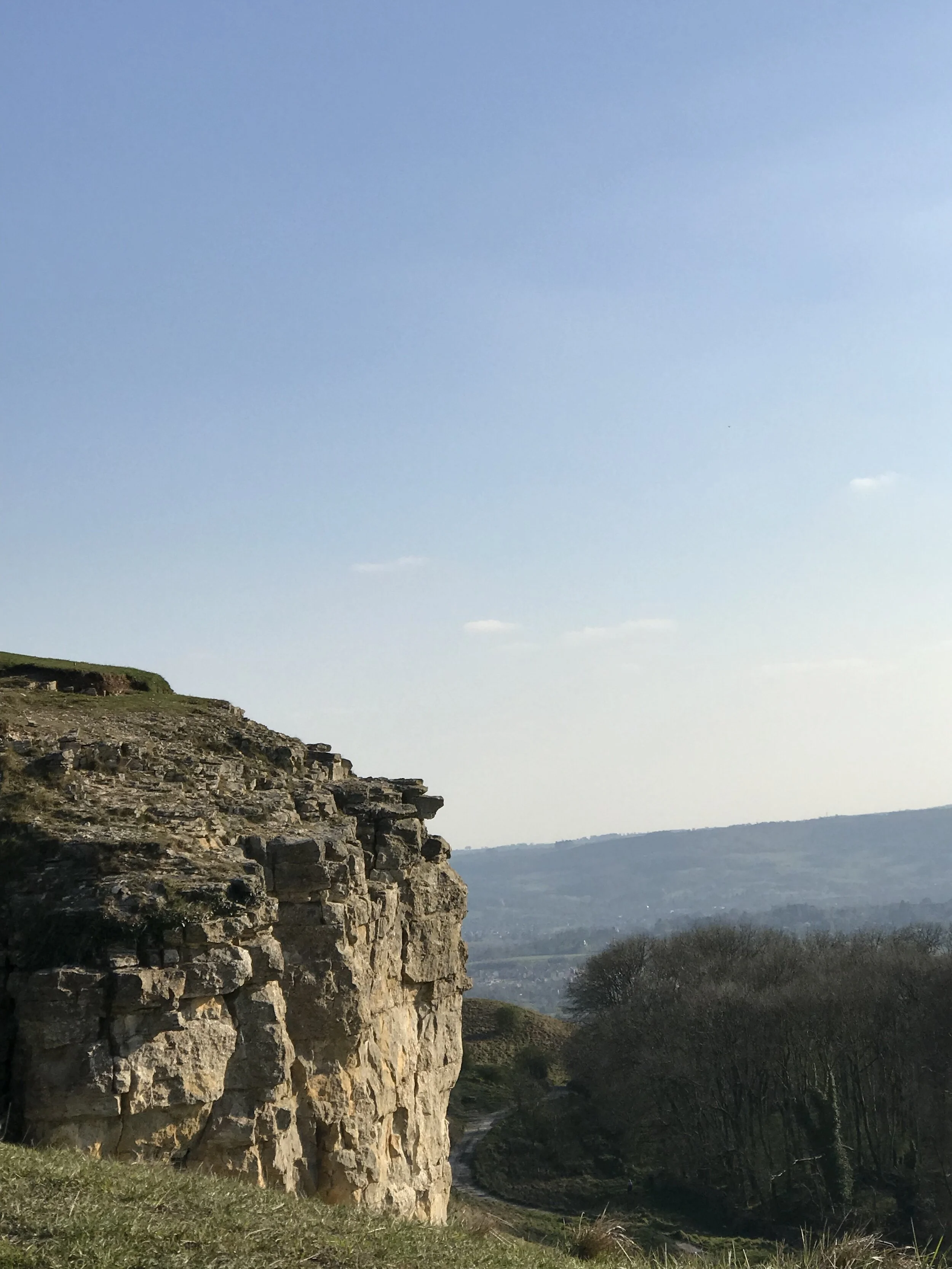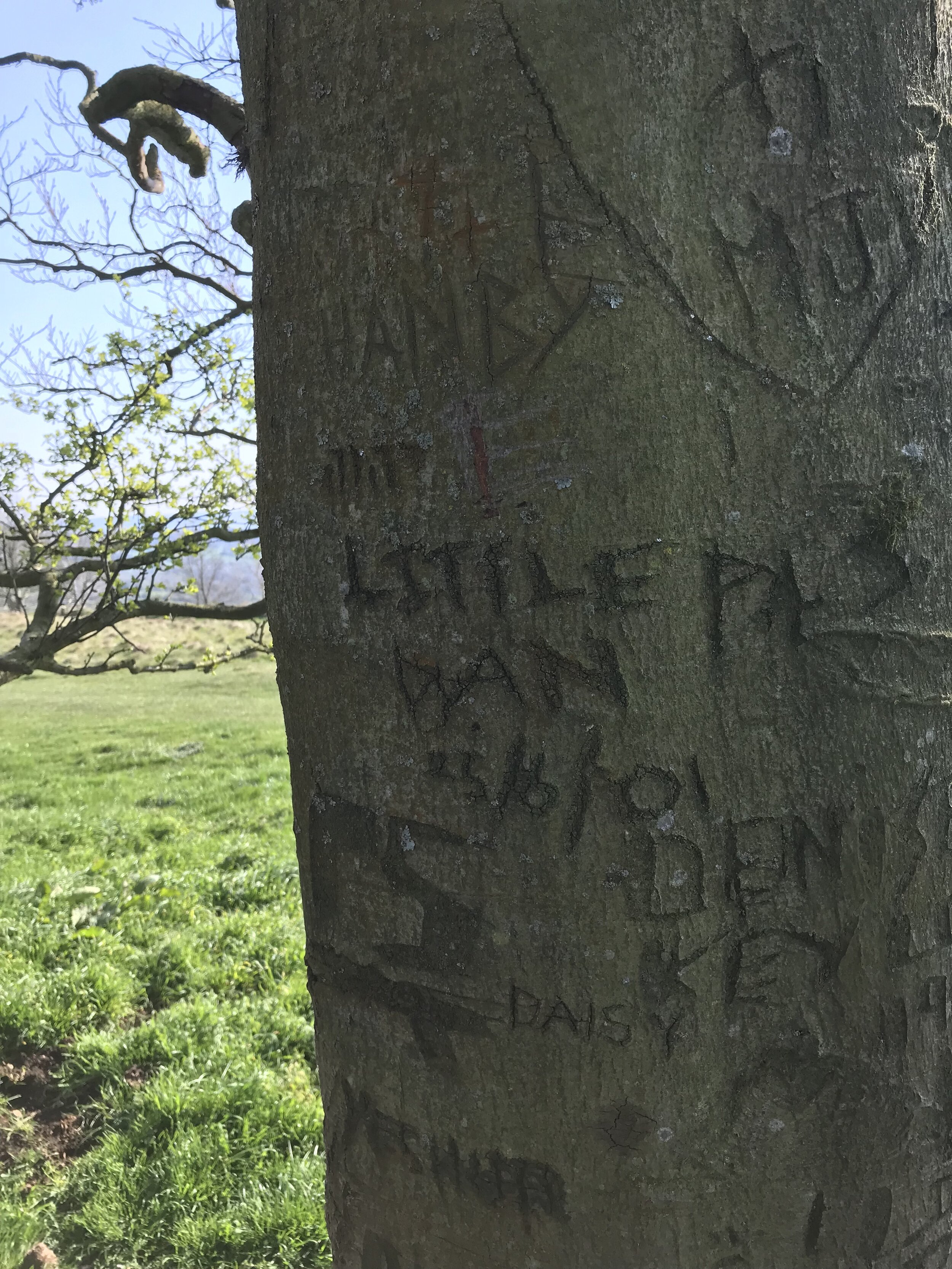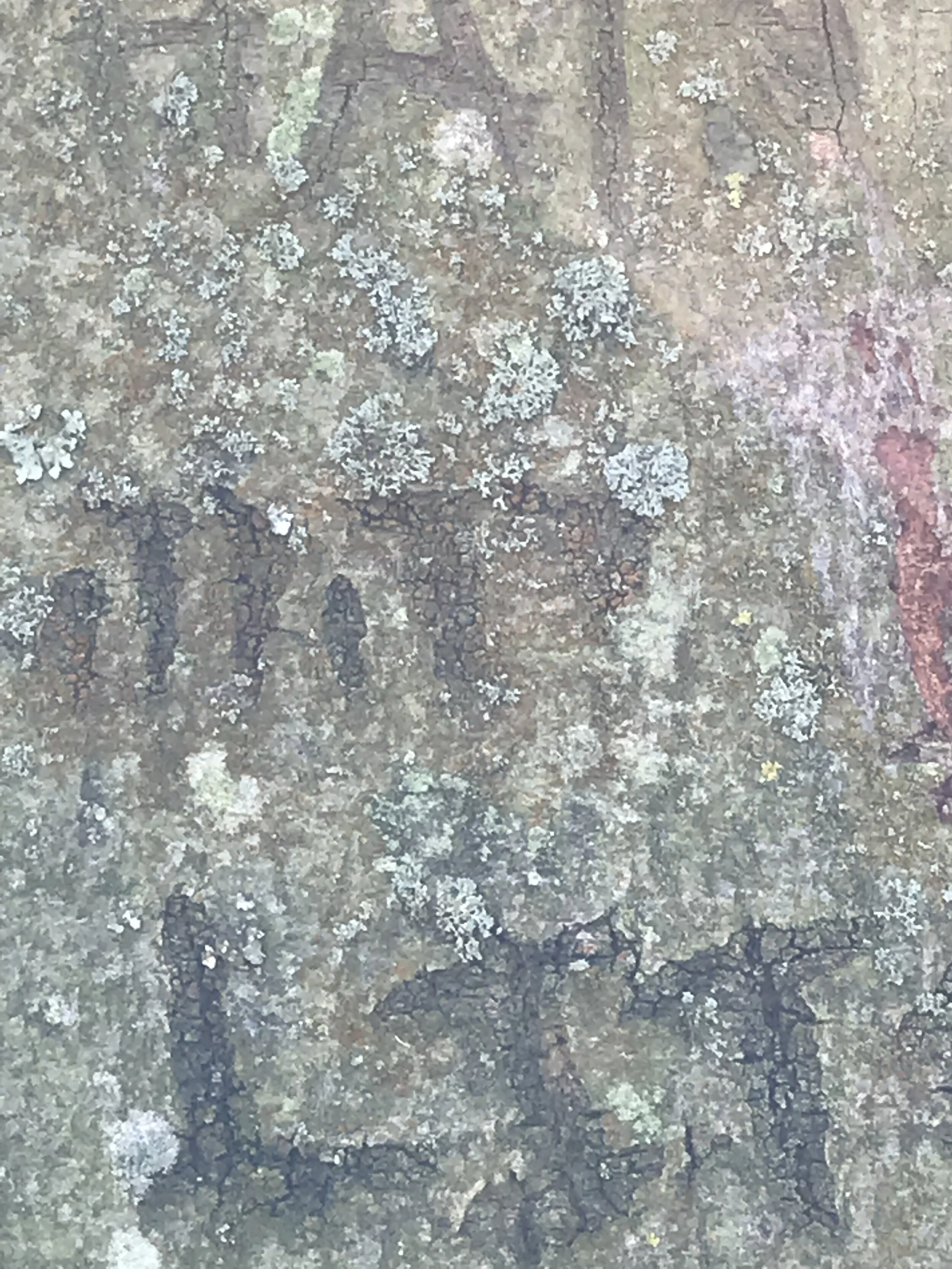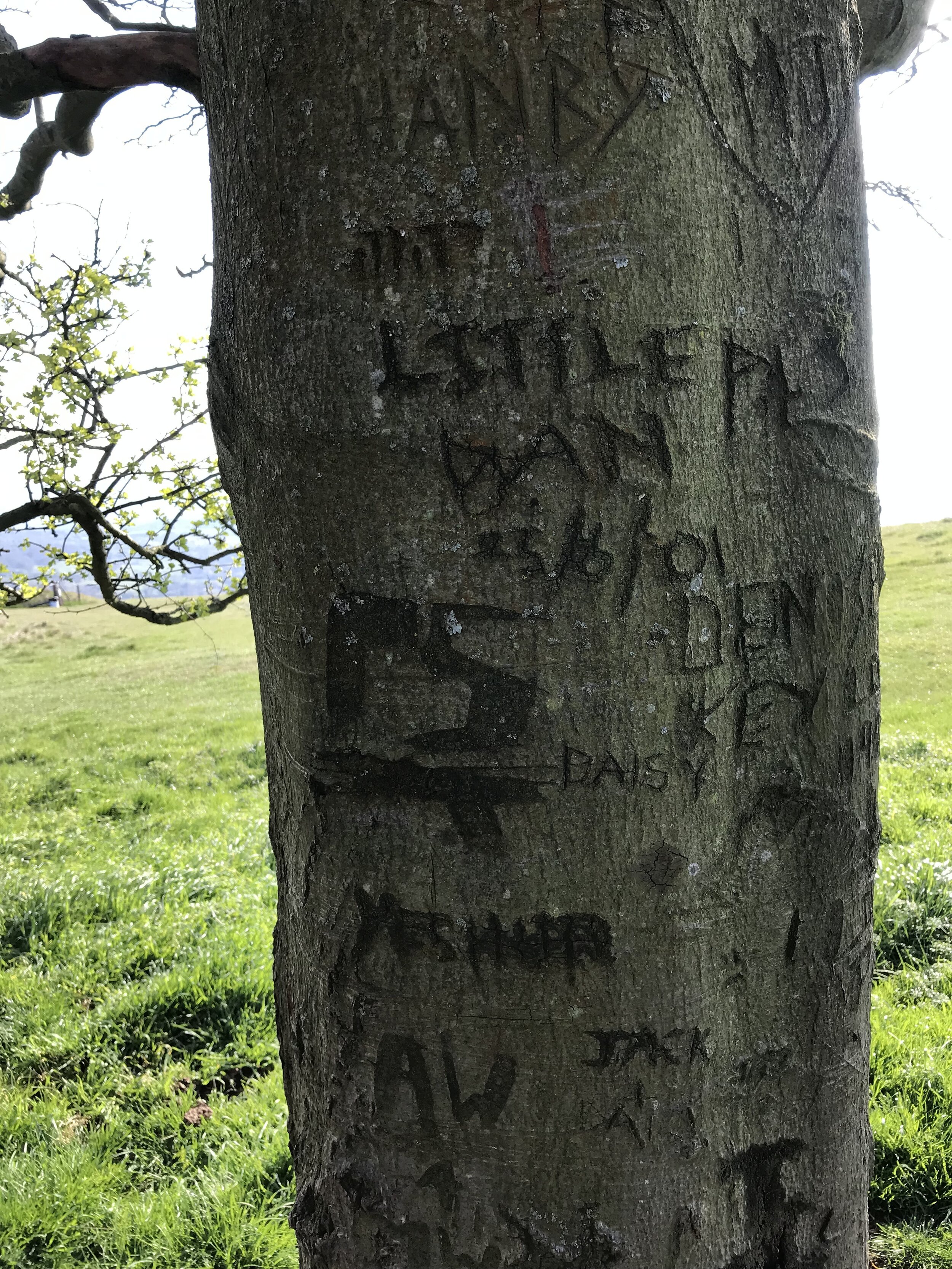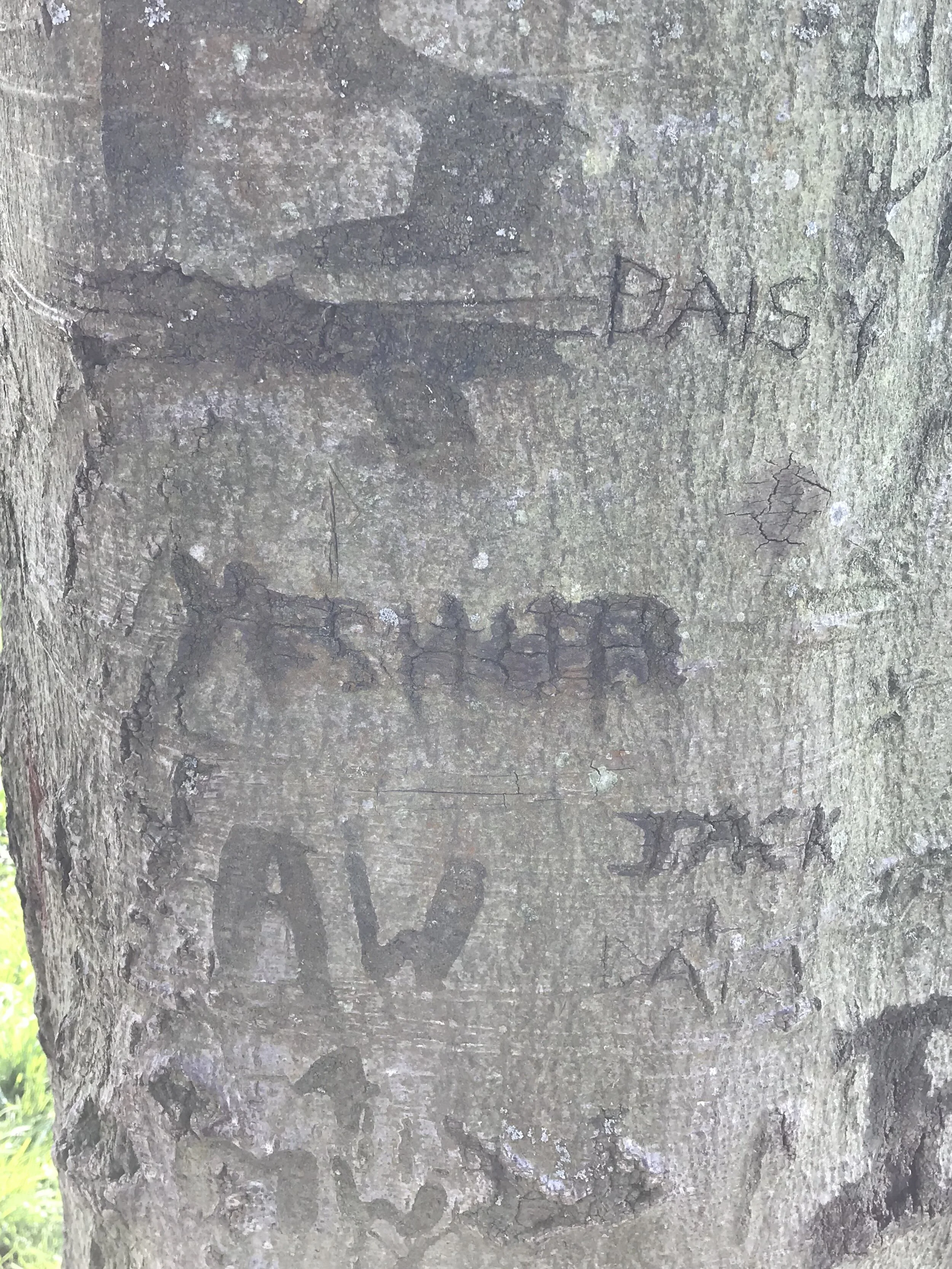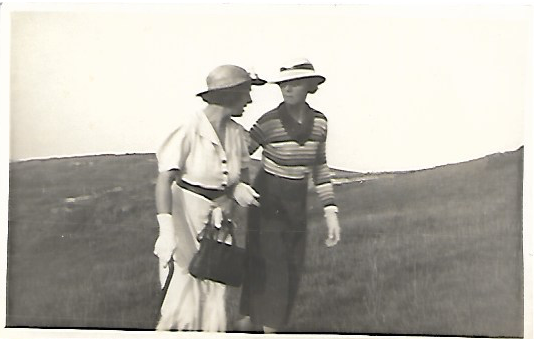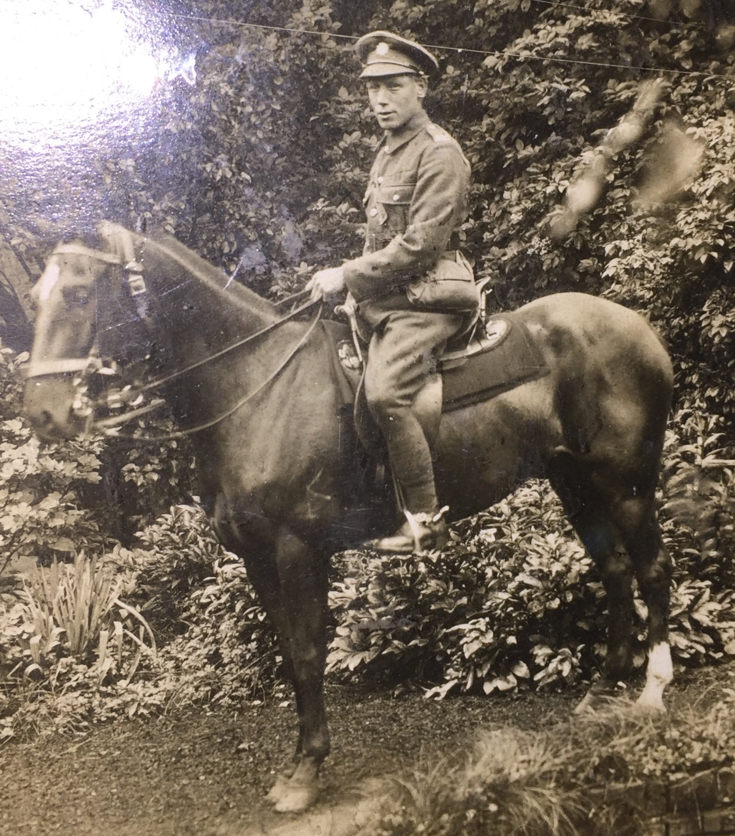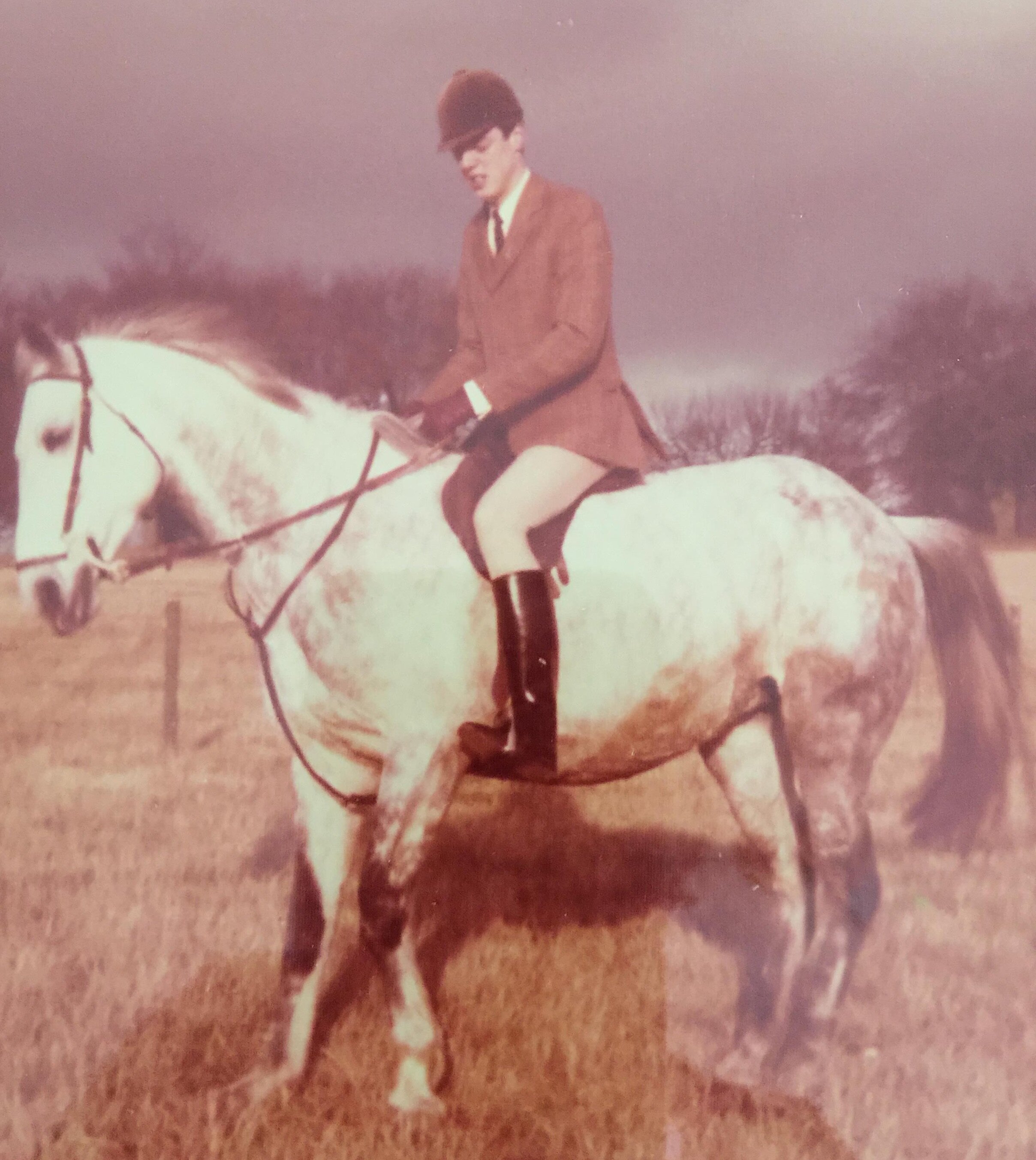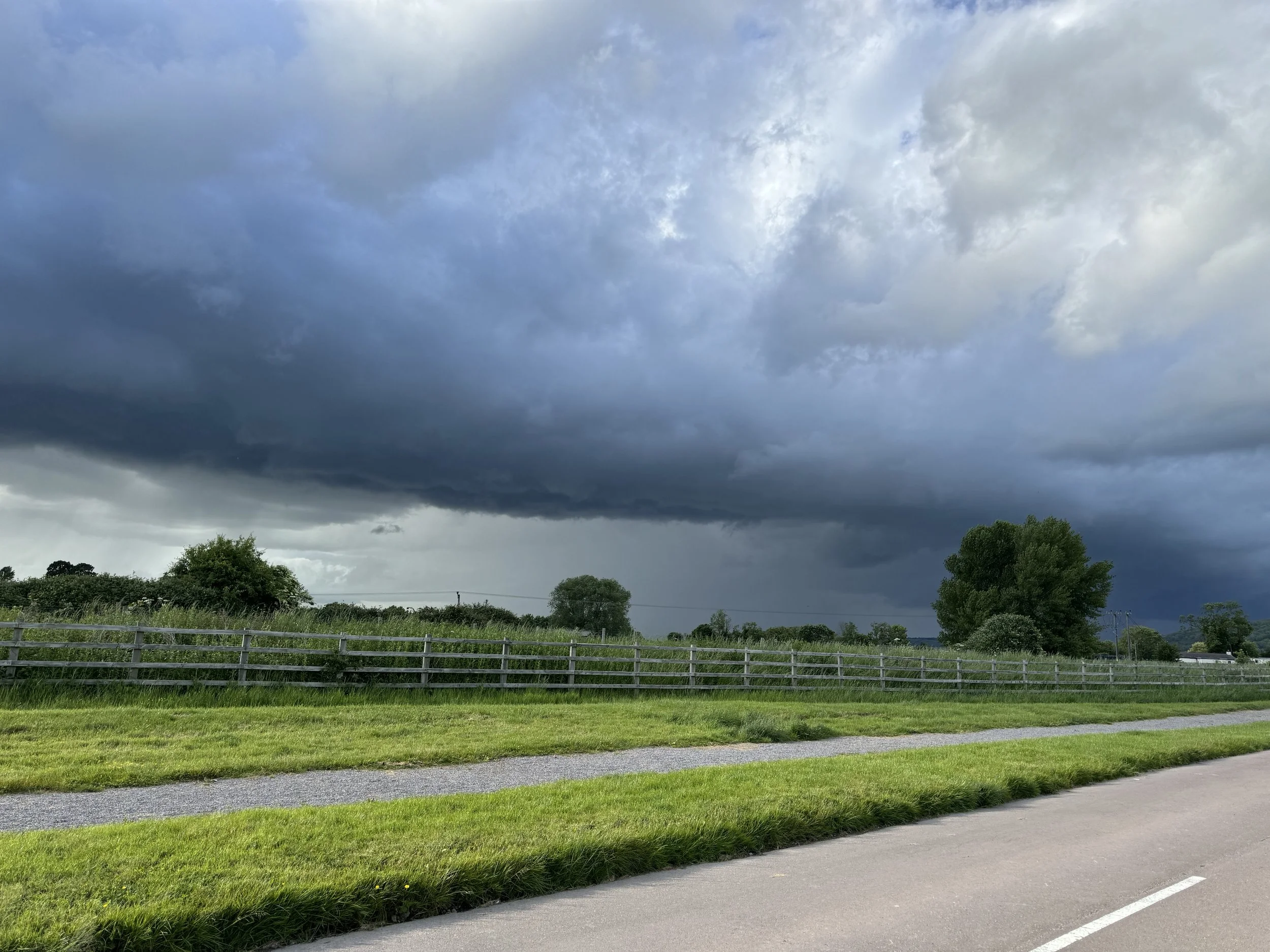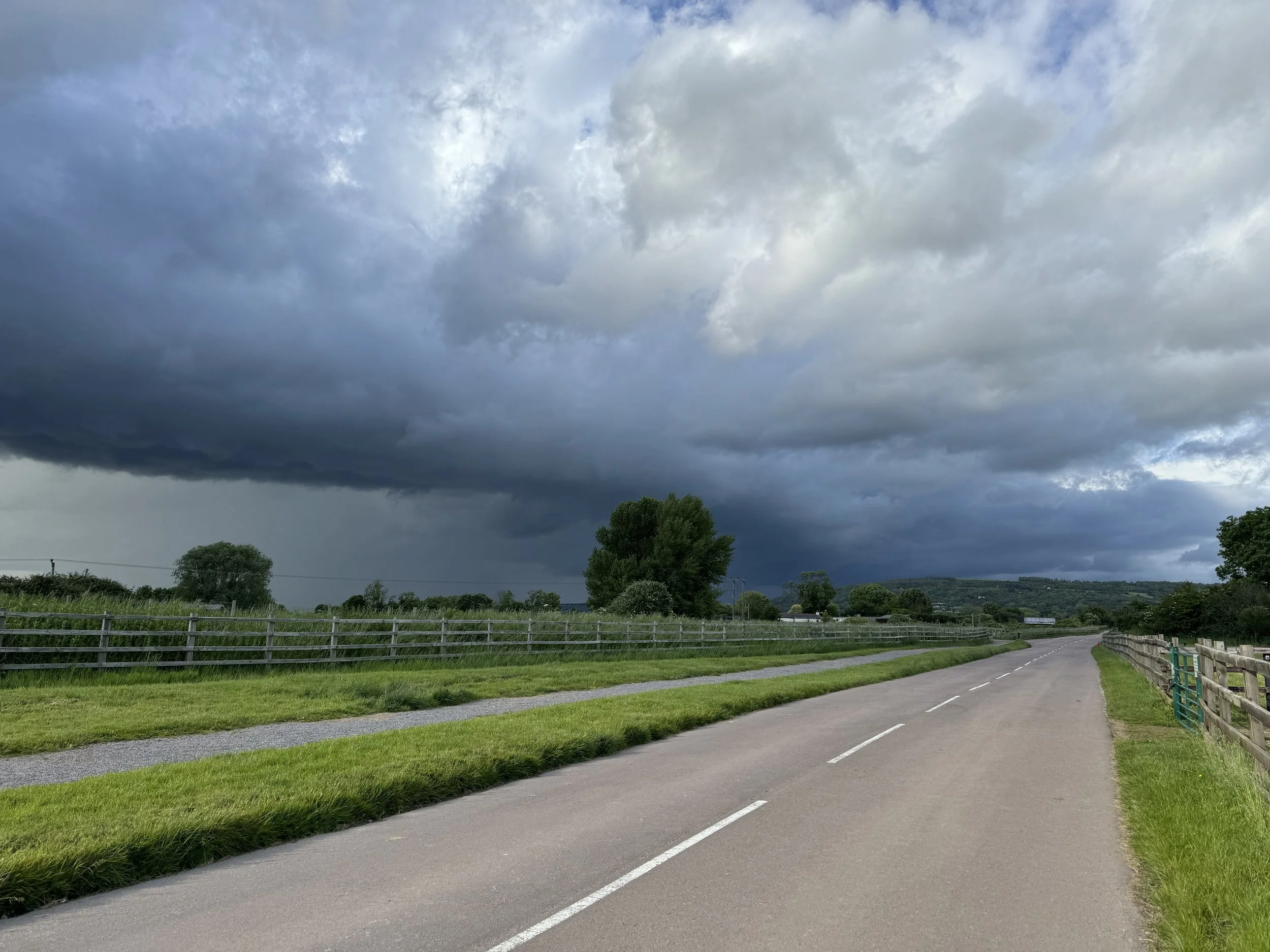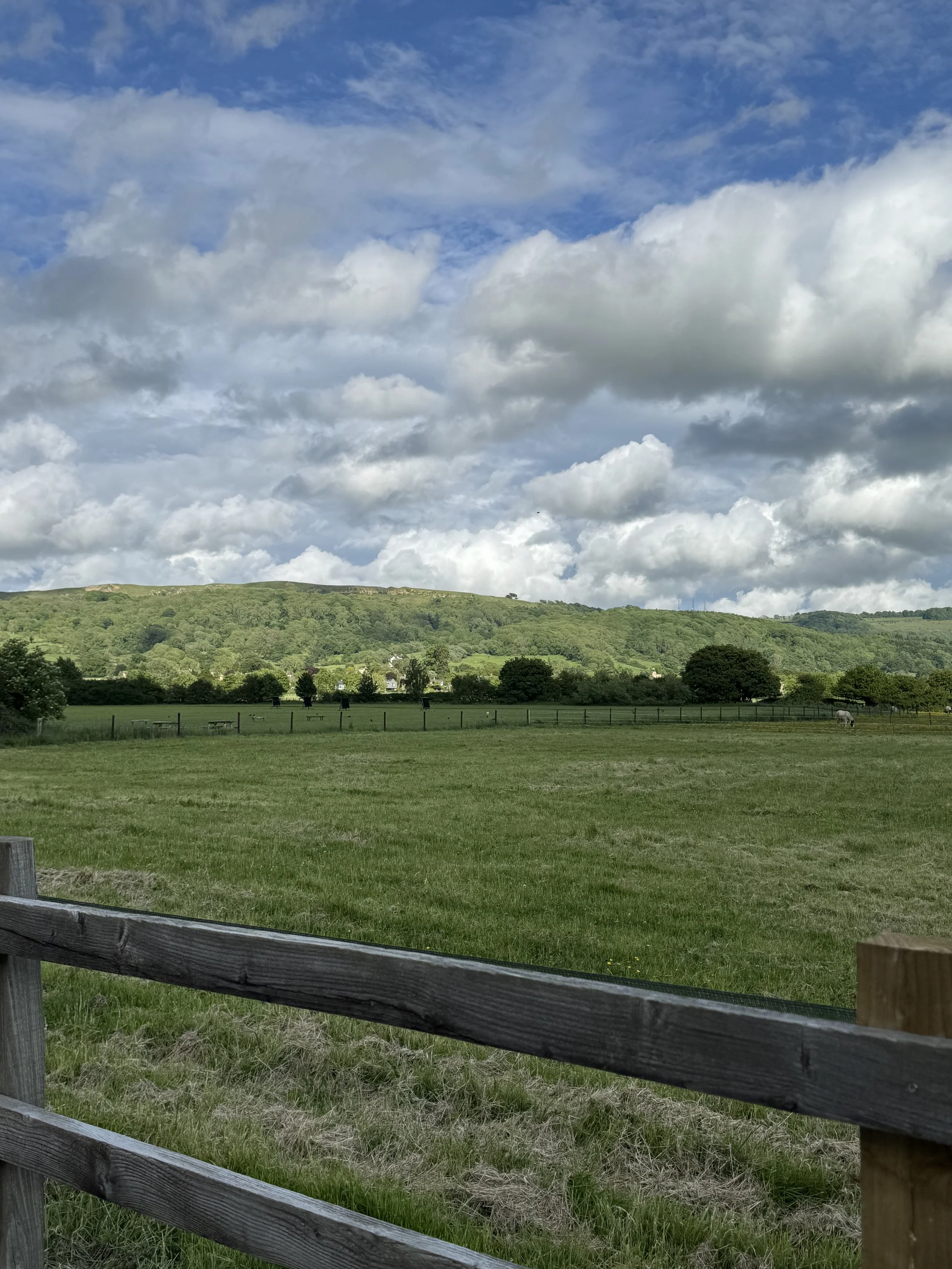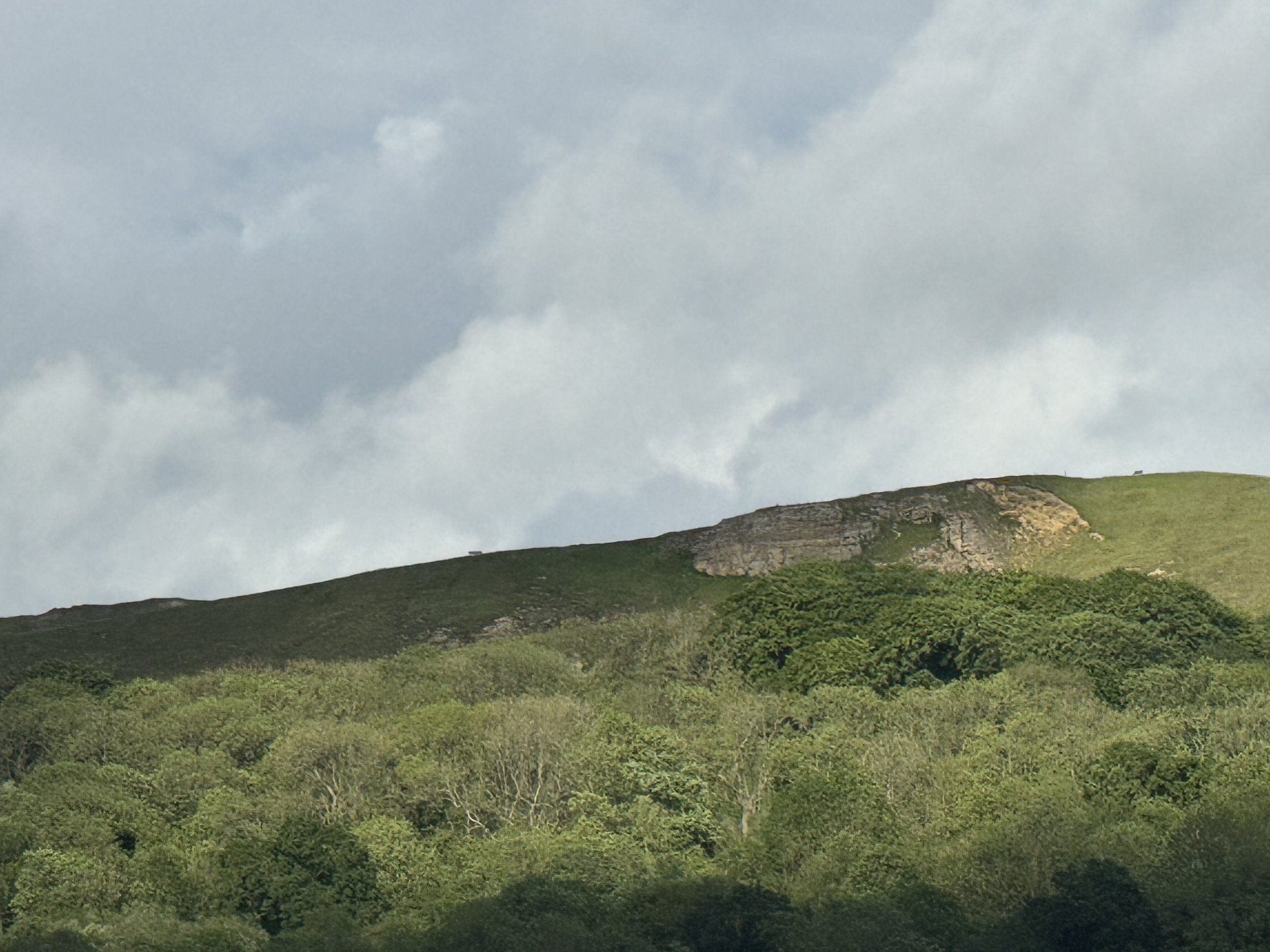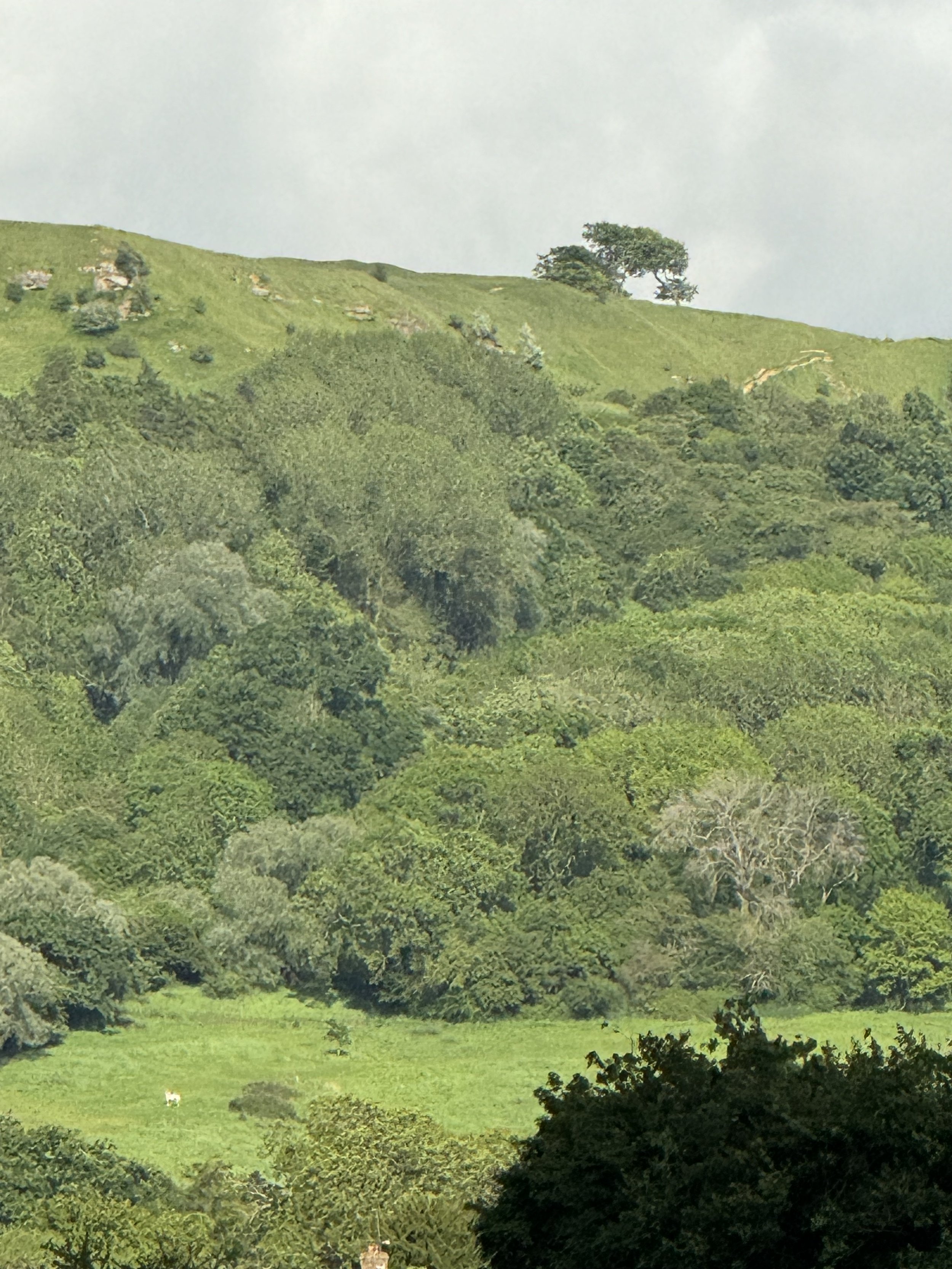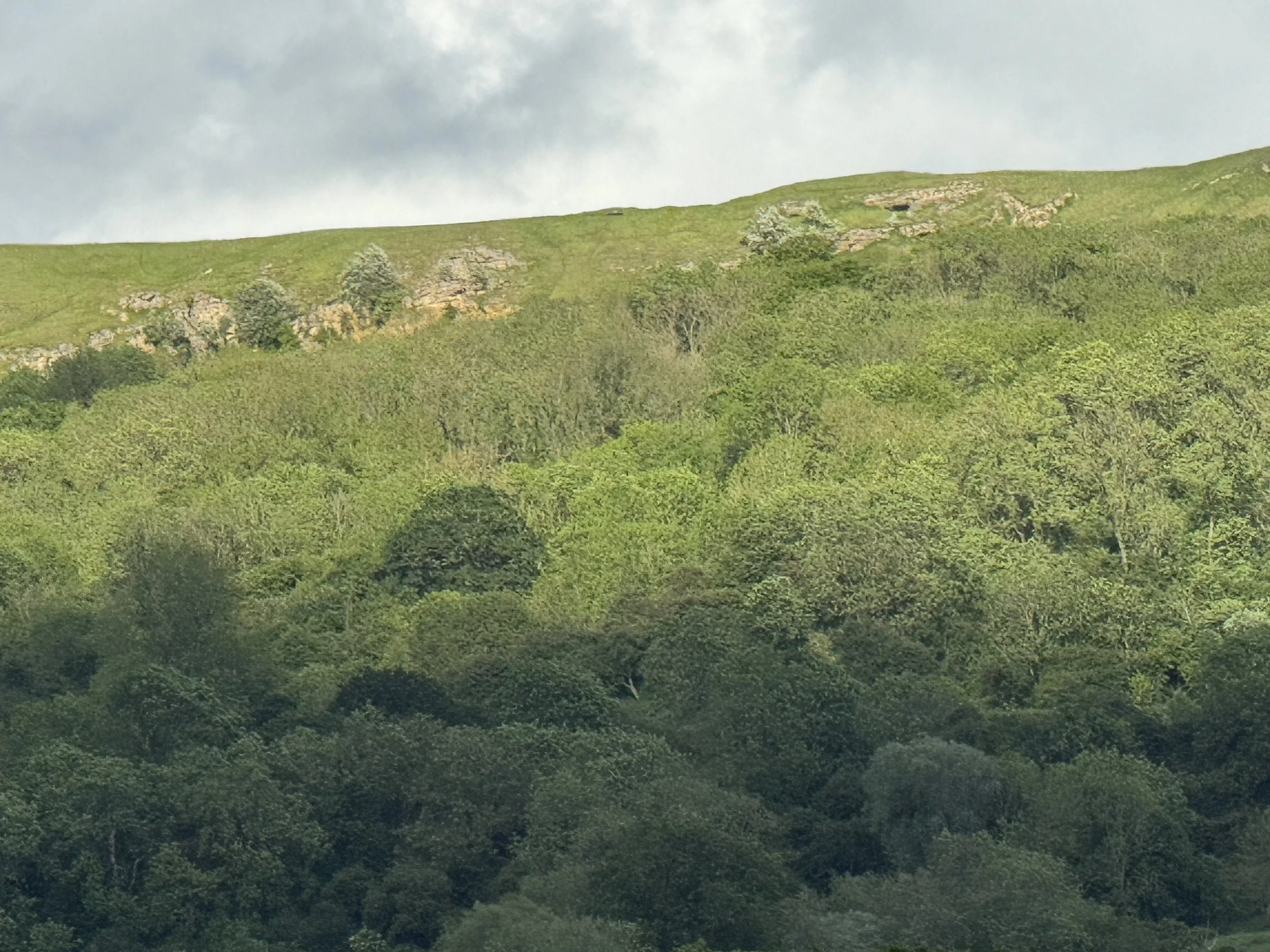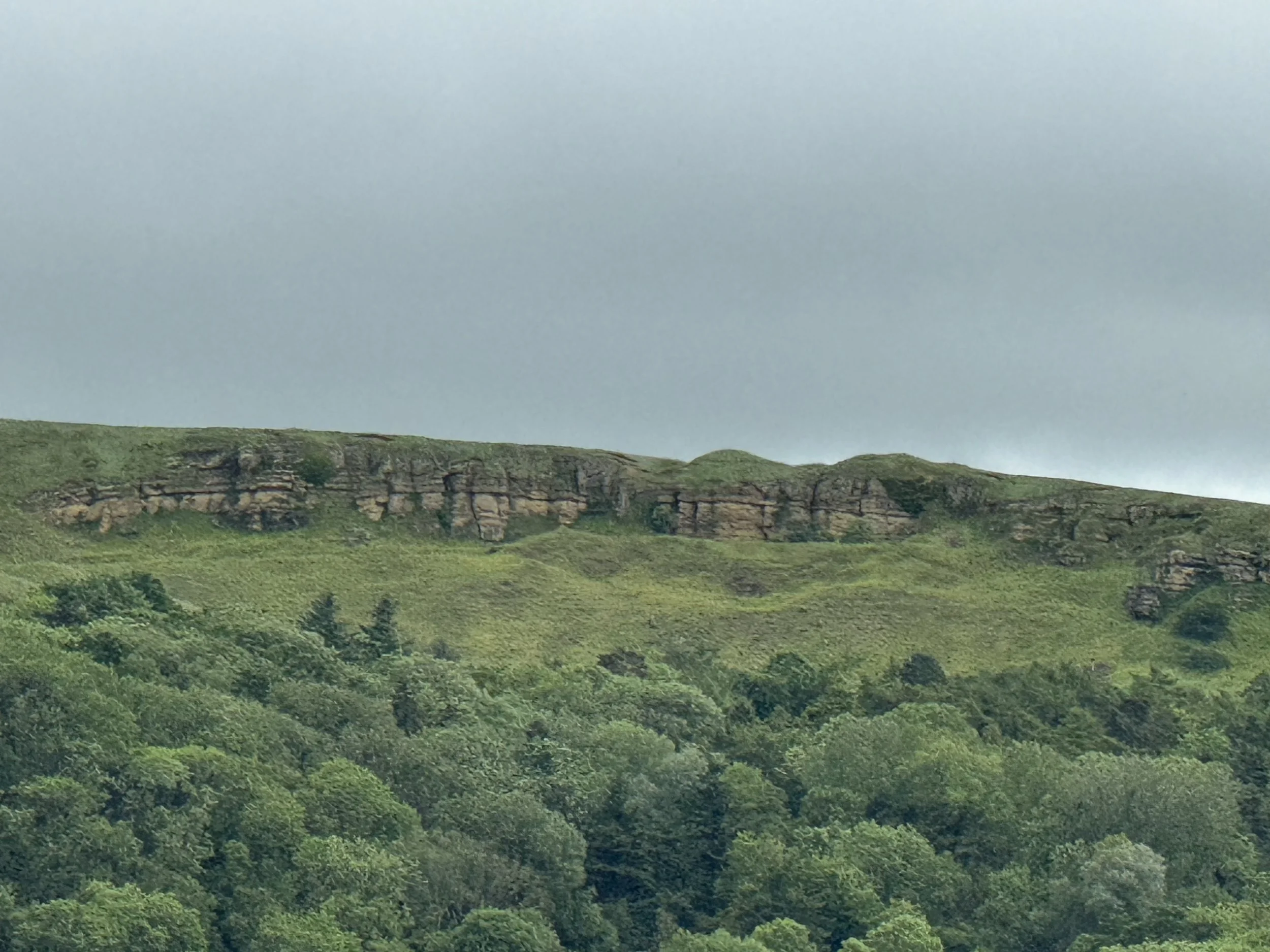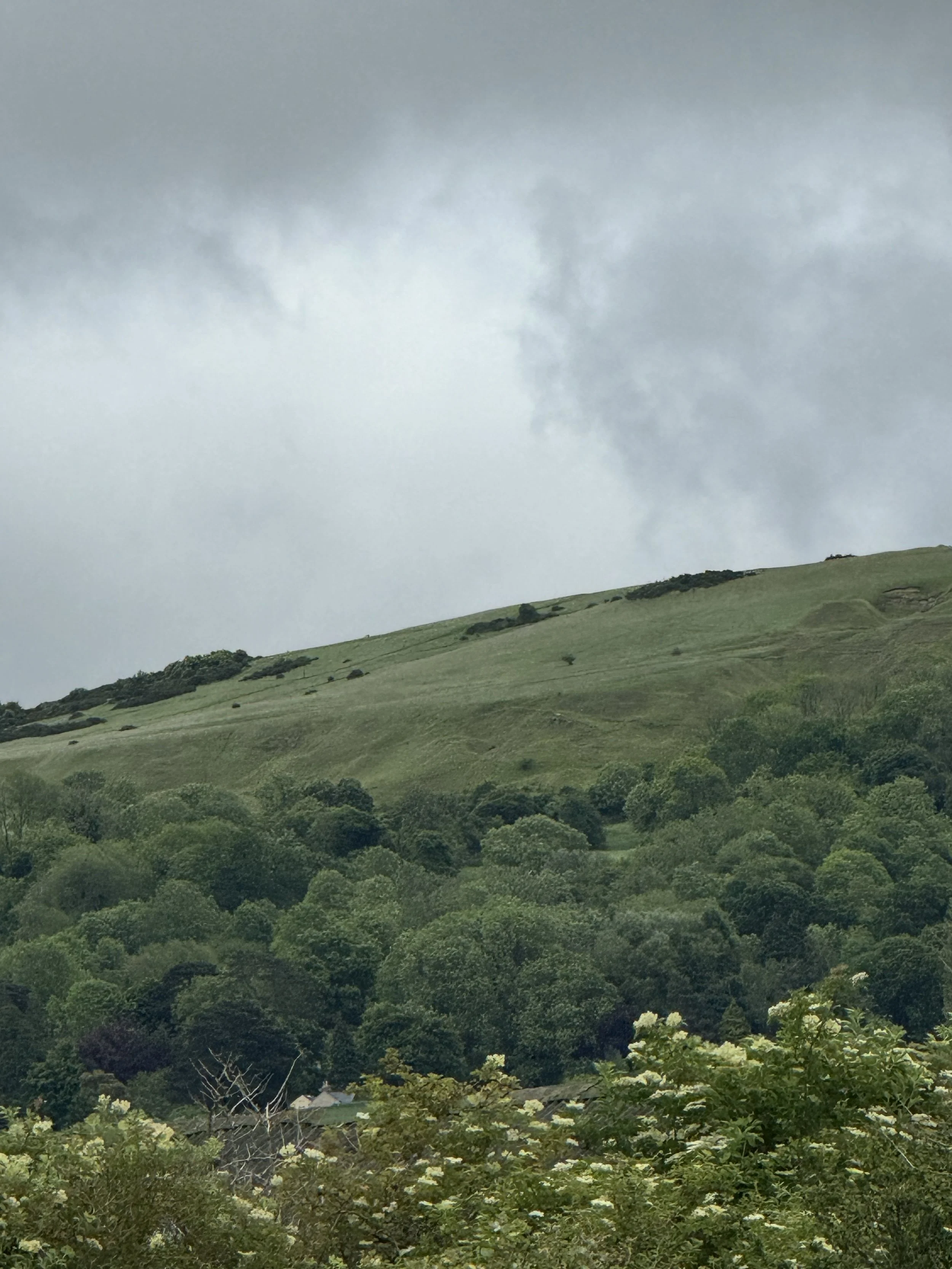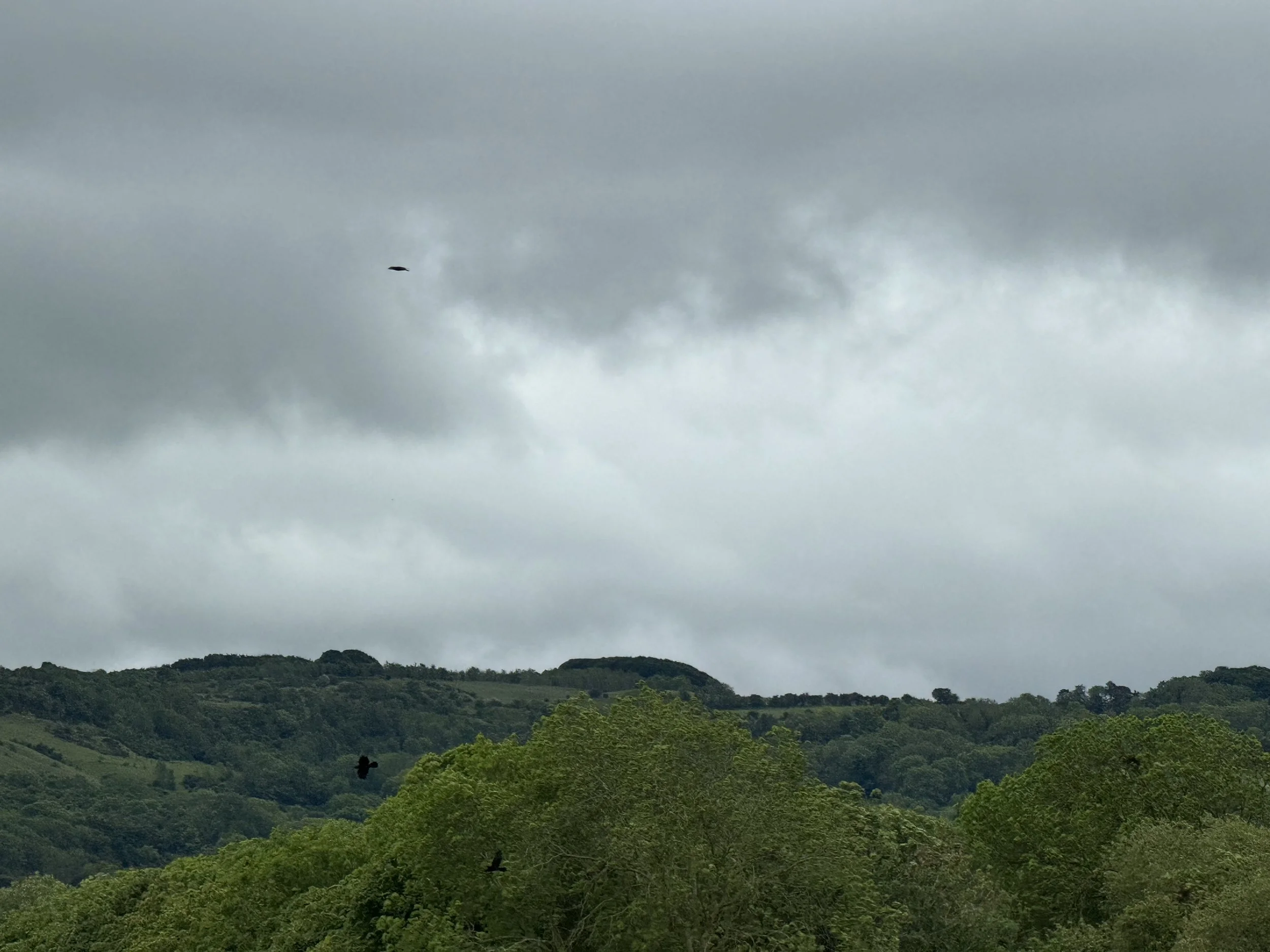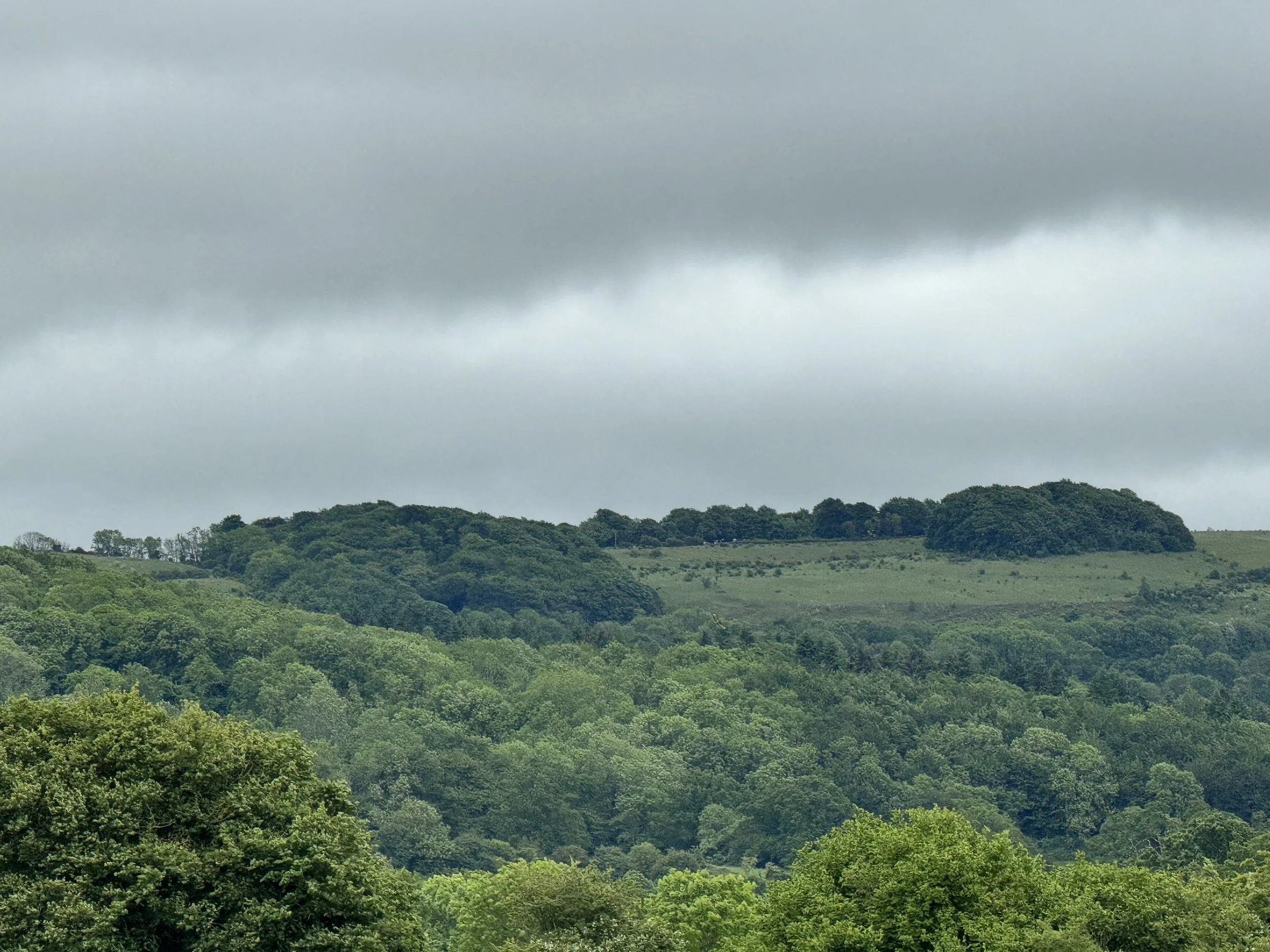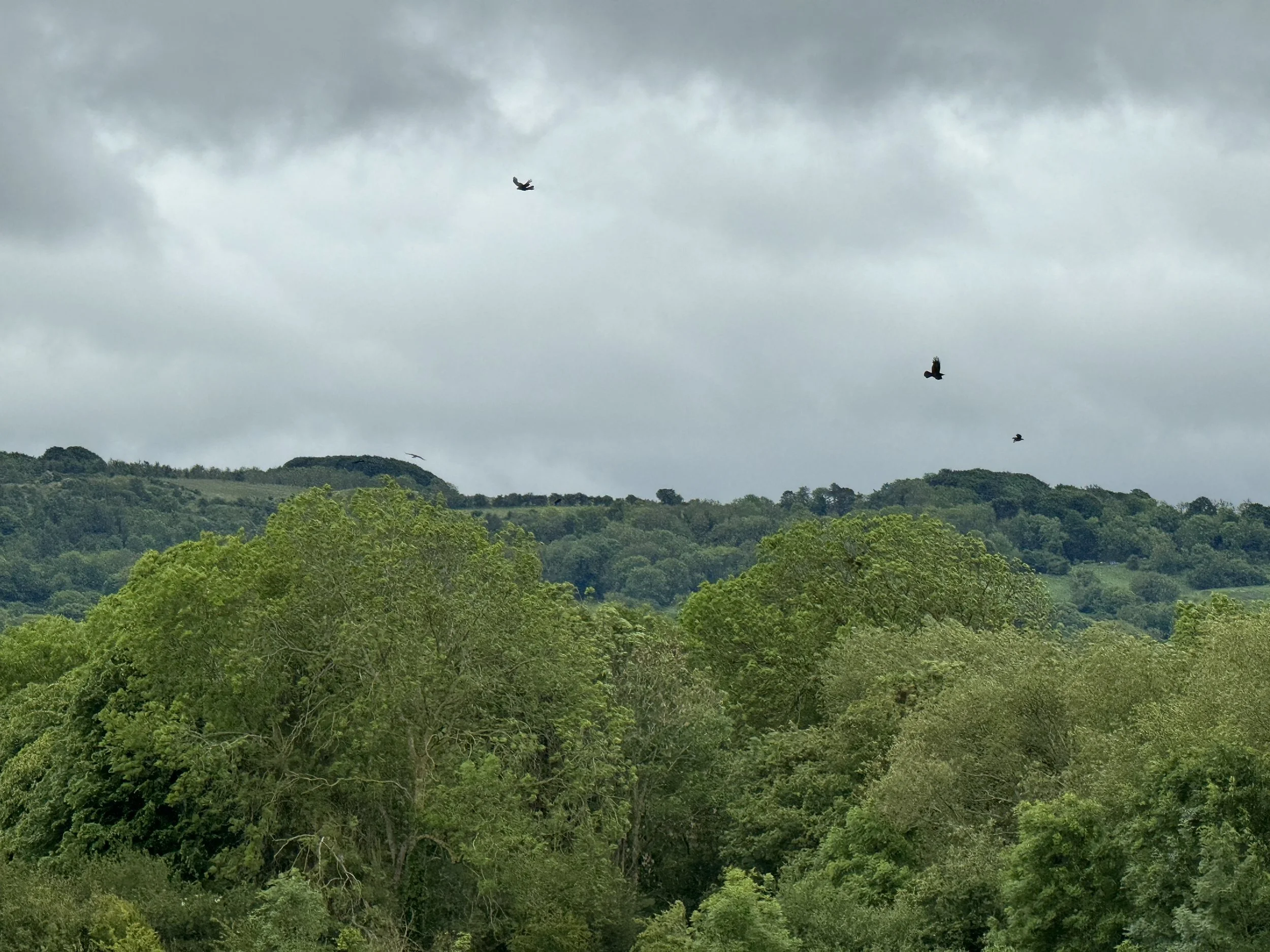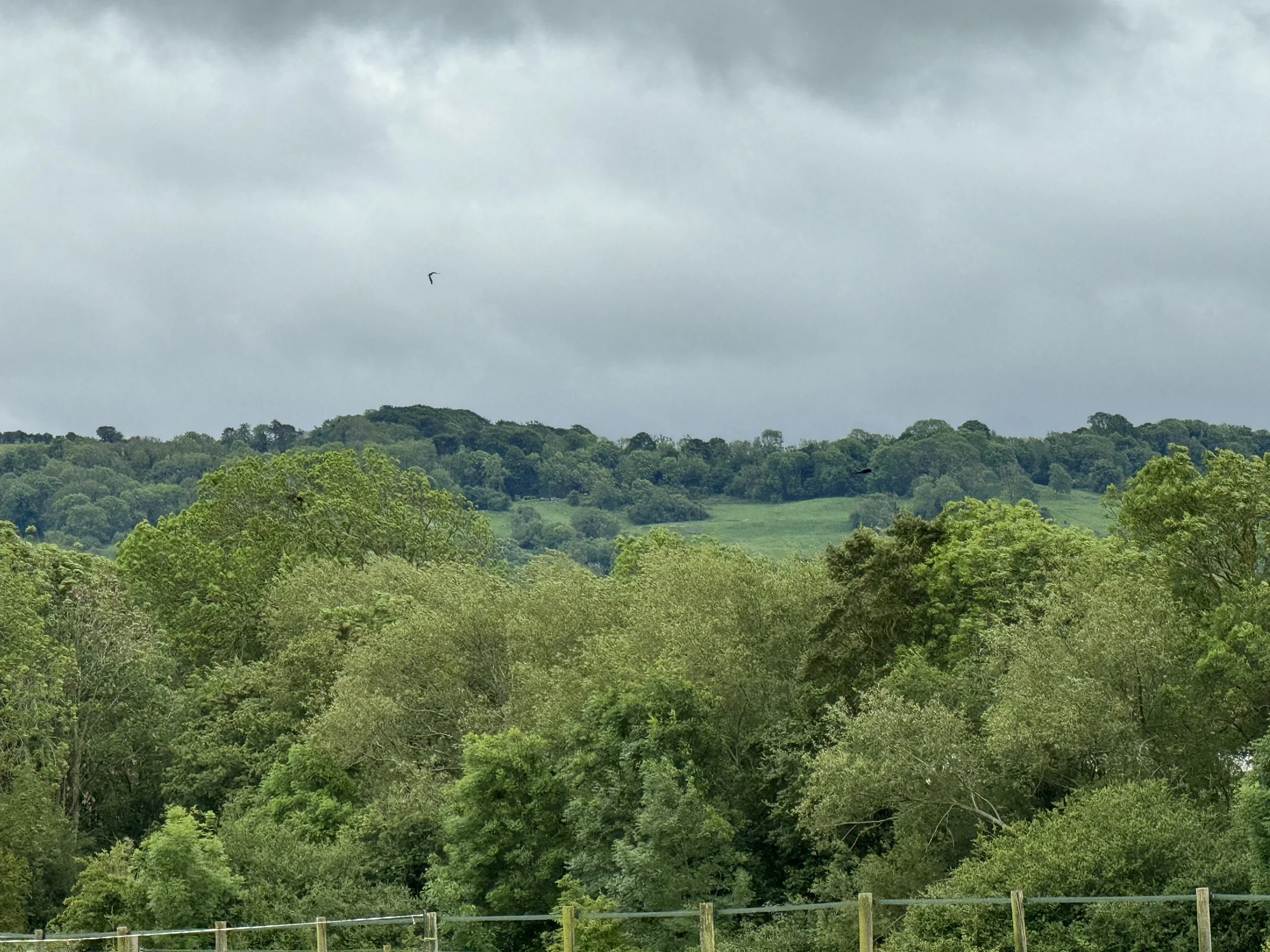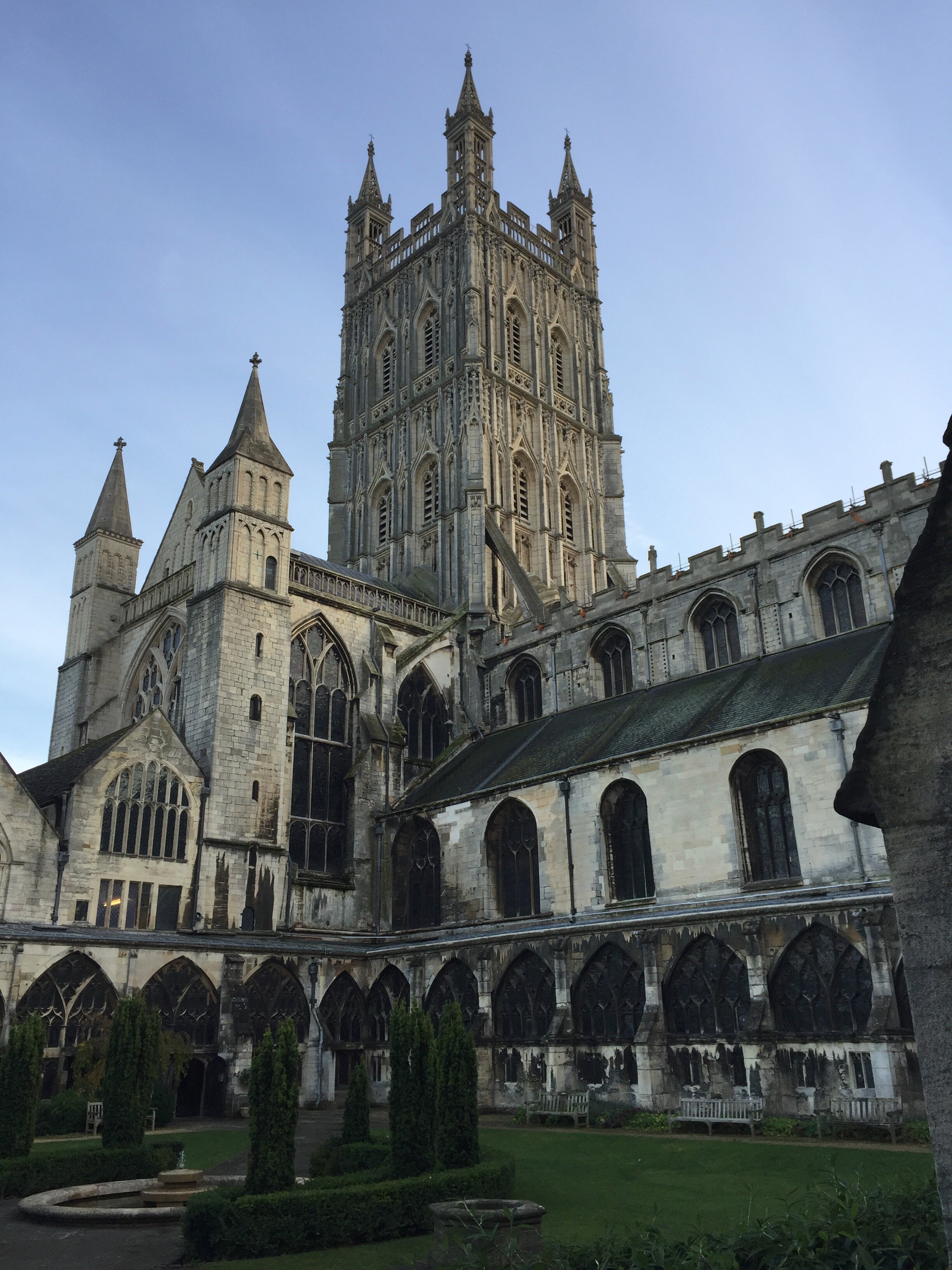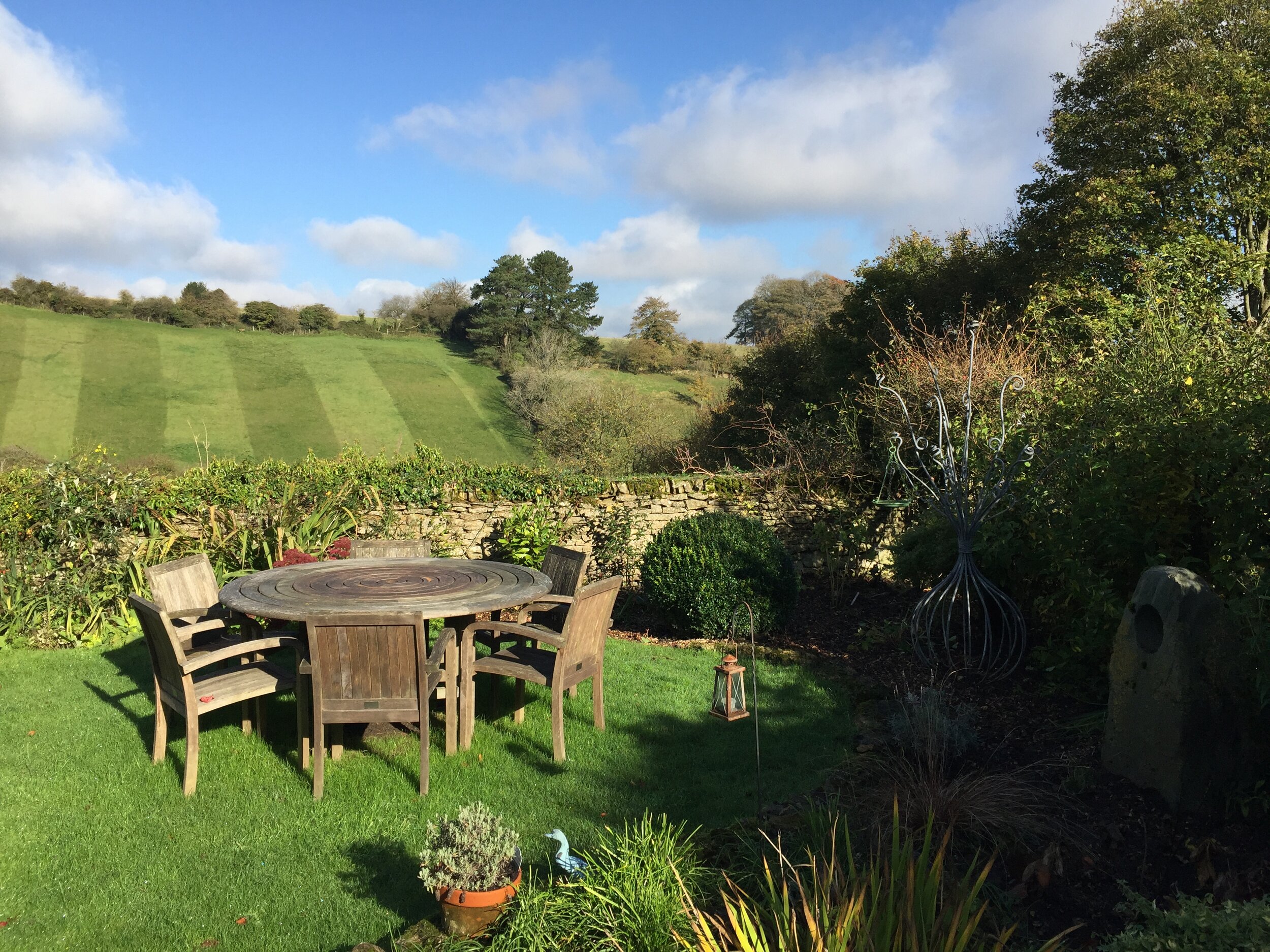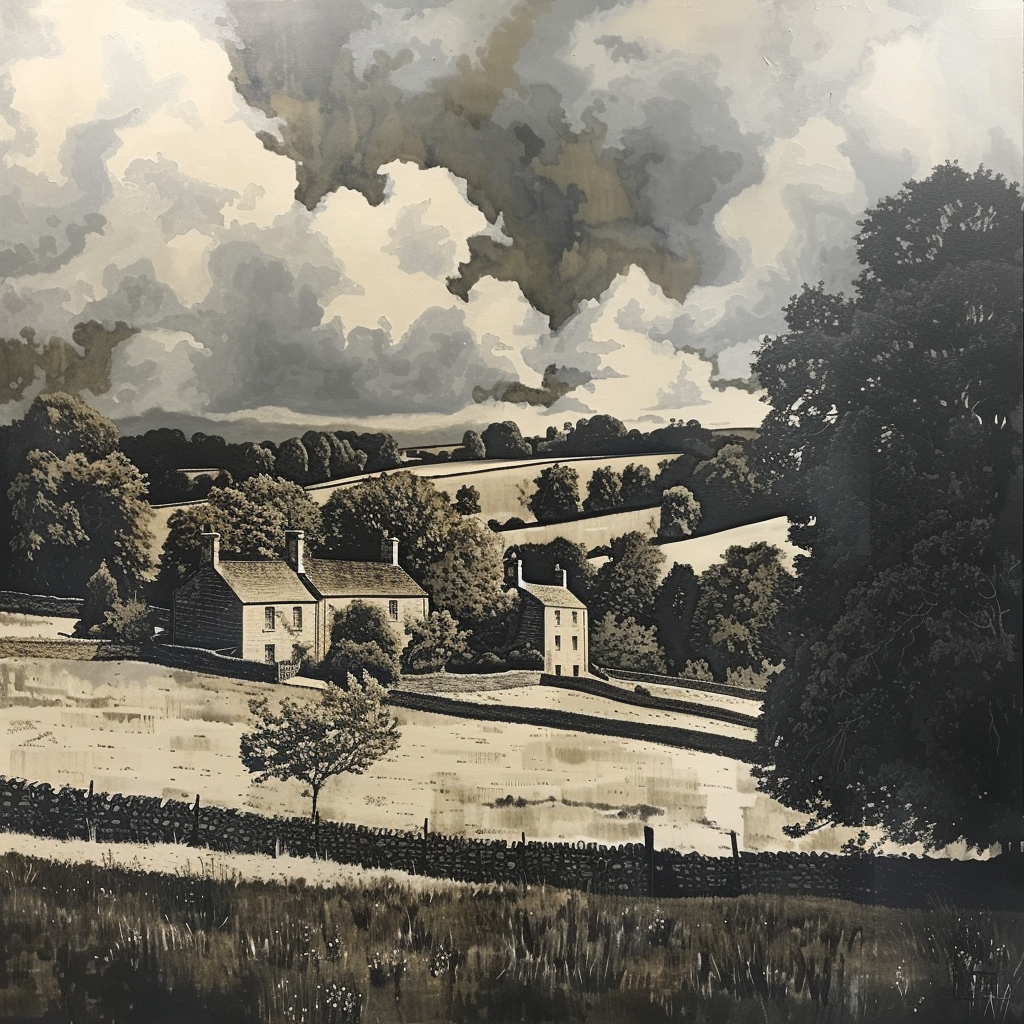Gloucestershire 2 ~ Cleeve Hill, the Escarpment to the Cotswolds (New Second Edition September 2024)
Gloucestershire 2
Cleeve Hill, the Escarpment to the Cotswolds
High above Cheltenham
The beautiful backdrop to the world-famous Steeple Chase Race Course
Image Courtesy of the author's artist and photographer Alexander Petricca of Liverpool and to whom all rights are reserved
I
WALKING OVER THE ESCARPMENT it is good to feel the wind straight off the edge as it glides the formations from southeast England – great cumulus clouds that must be sixty thousand feet or more and, I guess, somewhere over Oxford or maybe a little further.
Where I am, there is a long diagonal line that mirrors itself so that what I see is a depiction of angels’ wings. They stretch from their tip high above Cheltenham down over the south wolds of Gloucester and their apex somewhere over Bristol.
The light is remarkable.
As I glance back I turn to gaze across the great plains of the midlands (the mid-lands) but as we now say, ‘the midlunds’, the Vale of Evesham to my right, Tewkesbury crowned by its Abbey just ahead, and to the right of me, Winchcombe, down in the hollow of the valley with Sudeley Castle nestling gently within the deep, steep contours of the Cotswolds.
These angels’ wings catch my eye again – for that’s how they appear to me – awesome, wondrous, and colossal – and I can easily imagine the figure into which those wings are knit – beautiful, and very assuring.
Of course, it’s all in my mind I know, nothing more. But it gives me faith. It gives me hope and gives me a vision, without losing my insistence on looking at everything scientifically, to the consternation of the narrow-minded or downright dotty flat-earthers.
We all need these three essential ingredients of life – faith, hope, and vision. All of them are intertwined. They cannot stand singular. Even if you only have hope, the framework of faith and vision will also be there. And that’s a mathematical equation for me. Certainty.
So, there you have it; the component parts of Certainty – faith, hope, and charity.
II
As I see these wings, my eye catches a glint of silver, or is it mercury? Or is it liquid silver as one sees being poured onto an anvil or in the thin channel of a metal mould from which will be fashioned a beautiful ring, amulet, or brooch?
It is the River Severn. And geographically in my mind’s eye, perfectly equidistant between the landfall of South Wales and its counterpart the Mersey landfall, on the rugged and tempestuous coastline of North Wales.
And shimmering in the haze is one of the new wonders of the world – well that’s how I saw it when, as children, we watched its construction – the Severn Bridge – joining Wales and England and making it less exciting as we journeyed to this far-off country on the one hand, but staring in wide-eyed wonder the first time we used the bridge, and wondering too whether it would hold all five of us, our luggage and the dog, up! Happy days indeed!!
III
As we walk – you and I – over the escarpment, we see large horse chestnuts nestling into the hillside towards the Trig Point – grassy, very uneven – crater-like, almost. And that is actually a quite accurate description, though caused not by falling asteroids or meteorites millions of years ago, but the point of impact of a Halifax Bomber that came to its final resting place around 1943-44. I think all seven of the crew were killed, but I'm not entirely sure. I must check this out.
Handley Page Halifax MZ 311 EY
The Howes Crew
I never thought I would accomplish that when I penned the observation up in Blackpool in 2009, but seventeen years later in September 2024 whilst researching on the Gloucestershire Constabulary Archive - such browsing will never be wasted on the Archive’s superb website - a very helpful comment led me to another website, The Cleeve Common Trust, that provides a tribute to the Crew of Handley Page Halifax MK III MZ311 EY- of 78 Squadron formerly a Royal Air Force Squadron until 1943 when it was reallocated to No 6 Group Royal Canadian Air Force.
Using the definitive Nine Volume W R Chorley RAF Bomber Command Losses of the Second World War (1944 Volume page 395), Mr Chorley provides us with this detailed research.
The Halifax took off from RAF Breighton as part of Operation Gardening at 20:36 on Friday 25 August 1944 in the East Riding of Yorkshire for duties off la Rochelle, a French city on the west coast of France and a seaport on the Bay of Biscay, part of the Atlantic Ocean. Returning to RAF Breighton, MZ311 crashed into a quarry near Cheltenham, Gloucestershire, all seven crew being killed.
Flt Lt C M Howes RCAF Pilot and Skipper
Sgt J McArdle RAF Flight Engineer
Fg Off E F Freeman RCAF Navigator
Plt off F W McCartney RCAF Bombardier
Sgt E H Harris, RAF Wireless Operator
Flt Sgt H B Hamilton RCAF Mid-Upper Gunner
Fg Off J A Glenn RCAF Rear Gunner
Mr Chorley continues, confirming that the four RCAF crew members, along with Sgt McArdle RAF were laid to rest at Brookwood Military Cemetery, whilst the Skipper, Flight Lieutenant Howes RCAF is believed to have been claimed by relatives, and that Sergeant Harris RAF rests in Blaenavon Cemetery fourteen miles north of Newport CYMRU.
The Cleeve Common Trust confirms that Operation Gardening was laying mines off the coast near La Rochelle. As I write, we have this summer commemorated the Eightieth Anniversary of D-Day and the Invasion of Normandy. This quietly reminds us that the liberation of Europe was a terrifying undertaking. Putting this into some sort of context, Paris was finally liberated on 25 August.
My father recalled visiting the crash site in 1944 with his parents, and recalls the assistance given by local officials - possibly a Home Guard Unit - who were very sympathetic and understanding when my grandparents explained that their son had been flying a Halifax when it came down over Germany in April 1943.
Do please visit the Cleeve Common Trust website.
My thanks also, as always, to Mr Chorley for the outstanding lifetime’s work that provides us with the definitive Record of Losses of RAF Bomber Command between 1939-1945.
IV
Let Us Now Continue Our Walk
(as penned in 2009)
So we now continue our walk past the stables and the house that enraptured me as a boy and certainly influenced my purchase of Abbots Croft in Leckhampton in 1989 – a schoolboy’s classic drawing of a house – a door in the centre, windows on either side and three windows across the top and over a beautiful gabled arch and porch doorway.
Yes, I was indeed blessed to own such a home, and I realize now I should not have sold it. How foolish we are “in the moment”; how wise we are “in hindsight”.
Cleeve Cloud, Cleeve Hill standing at 1,083 feet (330m) at its trig point and with Leckhampton Hill in the far background, Cheltenham nestling in between the two. This is the Escarpment of the Cotswolds that gives spectacular views into England, north and east, and west into Wales. I took this image at 5.39pm Thursday, April 11, 2019 - the hint of Spring, and after an especially gruelling winter. It was therefore physically, mentally and spiritually uplifting to be back on the top again. IBM KTW
Come on, don’t dawdle. That wind is more than fresh. It can cut as keenly as a knife!
We’re on the top now, and gosh it’s windy. A gale more like, and I'm glad I've got my sweater. I’ll leave it off as long as I can, and thereby enjoy it all the more.
I'm walking around the escarpment on what is now a public path, well-worn, and with very pleasant mossy grass on either side, but which is rooted in an old sheep path. Large flocks still dot Cleeve Hill, and so in a way, this is a dual-purpose path, with the occasional clump of wool or droppings.
As we traverse the southwest face, the wind is strong but not unpleasant; we still have the warmth of high summer and in the high cumulus clouds we have wonderful contours – greys, blues, yellows, ochre, all blending so incredibly beautiful, they are nothing less than in symphonic harmony.
When I fly, I love following the contours of these great mountain ranges, hills and valleys of the sky – this other realm – haha – who said that? How does it go? ‘...this other Eden, demi paradise.’
V
As we climb the gently listing slope to gain the high ground, two trees and a smaller third one – a sapling – come into view.
“The Three Sisters”; legend has it that in the dark past of warped Christianity and frightening fundamentalism, three sisters in Prestbury Village at the foot of Cleeve Hill were accused of witchcraft, and found guilty. As befits that warped society, they died horribly. Then, as so often happens, the spirit of enlightenment – or is it a guilty conscience indicted by None Other than the Holy Spirit – the Ruach HaKodesh – discovers the maladministration of justice. Shock – horror!
Weeping, wailing and gnashing of teeth, beating of breasts and then remorse of a sort. Vicious, spiteful tongues are, for the moment, quieted.
So three trees were planted in their memory on the very edge of Cleeve Hill immediately above Prestbury, like three sentinels standing guard and as a warning to all, especially, I guess, to those who are perhaps just a tad too literal and dogmatic in their faith. And even now, three hundred years later, there are still plenty of those benighted souls around!
And I grew up in their mystical, powerful, other-world embrace. As kids and teenagers and latterly adults – they always seemed to have this impromptu pilgrimage. And still do, to this day.
VI
In the early 1990s, the weakest of the three finally succumbed to the elements, and I’m glad that it took the townspeople a decade at most to plant a sapling. What’s more, they placed a seat there. I've used it many times. And from there I would look beyond to Leckhampton and find the largest tree in Cheltenham at the end of Asquith Road. And that tree was like the sound of the sea to me from the veranda of my home in Churchill Road. I’d be happy to transport it up here in Liverpool, I admit. Warm and cosy, spacious in the winter, airy, light and cool in the summer.
As we look over the common with our backs to the escarpment we see just a few yards away a copse – some trees within a fenced glade – a natural sheep pen. Incredibly warm there, too.
Many times have I gained protection there from howling winds, rain, hail and snow – all seasons it offers some form of protection even when on military exercise – but in summer it is bathed in the beauty and glory of luscious green leaves; shades of all colours, an artist’s dream of textures and delight.
If you look closely on the main trunk in the south-west facing corner there are some carvings in amongst the hearts and forget-me-nots of true love and adolescent cravings.
Two, in particular, are a statement – a proclamation – faith, hope and vision again: Hebrew for YHVH is known as the Tetragrammaton, the ineffable name of God.
They are pronounced in Hebrew "Yod Hey Vav Hey" when you read them in the Hebrew manner from right to left.
Hey Vav Hey Yod.
In other words, God's name is actually inexpressible in the human voice and can only be represented in language when it is considered more of a visual representation of what His Name means, and the Name above all names – YESHUA. Or in Hispanic, it is pronounced ‘Hey-zoos’ but spelt, ‘Jesus’. This, I admit, tries my patience, because I tend towards seeing the ancient scribe getting carried away with himself.
But I’m glad they are still there. It must be getting on for twelve to fifteen years at least. I’m glad too for another reason. It means I can look at all religions; I can obtain an understanding of faith by whichever means a community chooses, without losing the plot and becoming narrow-minded, closed to all thought, reason and explanation that might seemingly contradict my own take on something.
Goodness! When I carved the Name Above All Names and the Name I was told I was not to mention, hence my rebellion, this bark was clear. I seem to have started a trend. But this is a time-honoured tradition. There are right places and wrong places. There is that which pleases the eye, there is that which seeks to wreck society. The larger the graffiti in our towns, cities, villages and hamlets the world over, the smaller and punier the mind behind it.
Come! It’s windy here. Let us move on!
VII
It was on a very fast ride across the Gallops, a famous part of the Common above Cheltenham Racecourse (and which countless TV watchers will recognise as the hills and skyline on TV commentaries as they contemplate their winnings or, more likely, losses), that my horse and I temporarily parted company! I remember jumping the gorse bushes (all those yellow flowers) and the next instant flying through the air.
And, upon crash-landing head-first, looking up to see the bellies of the other horses jumping over me; I remember the noise too!
I actually found my horse down on the escarpment below The Three Sisters, we’ve just been visiting, grazing. But little did I know what lay in store. Concussion, epilepsy and discharge from the police force, reinstatement on appeal. Then discharge again on the same grounds but this time finally, a wrecked career. But hey ho that was in the olden days, 1981.
It didn’t stop me from riding.
Riding is in my blood, and though I have never said this to the family, on all the countless wonderful rides I've had up here, (and elsewhere in and on the Cotswolds) I would imagine Grandad, a very fine horseman, riding beside me, encouraging me, teaching me to sit tall and straight in the saddle, to push the heels down, to ride with one hand to keep the saluting hand free to pay compliments, to go ‘with’, not ‘on’, my horse, and to not fear as I then leaned down and in towards the neck, streamlining as we went into the full gallop. Yes, truly marvellous times. I must also put the record straight. Falling from the horse alone did not lead to career change. I look back now and recall at least three public order situations in which my head took knocks. Apart from being “a little shaken”, one would have a mug of tea and be back on the town within an hour or so. But I now realise I was slowly collecting damage.
I digress.
VIII
Oh, what a horrid day that was on a bleak January morning, wandering around Cirencester town centre, realising that I no longer had my police warrant card and that by the month’s end I would never again be the holder of that ancient office of constable.
But we must move on; for a career change and a whole new life that had not been planned or prepared for, beckons.
So often we are at the mercy of circumstances beyond our control. Think alone of the hundreds of British servicemen and women who’ve lost their lives in the war in Afghanistan; the wreckage to entire families and circles of friends that will never be fully healed. And the same is true of earlier wars, tracing back along the timeline of history as far back as time itself permits.
As we walk on, heading due south with our backs to Cheltenham and in the distance behind us the Malverns - that line of hills running south to north that seems for all to be the very backbone of England - we approach the police wireless masts.
IX
We are now right at the top of Cleeve Hill; to our left is the trig point and it’s like being in the middle of great moorlands. And yet when Graeme (now a squadron leader in the Royal Air Force) flew me over Cleeve Common I was amazed to see just how small it is. Is THAT where we held all those military exercises?
The winds are strong as we head up to the trig point. Today we have clear skies and cumulo-nimbus – but many times the clouds come right down to the ground – and then it’s very unpleasant, wet, dank, and miserable; and that is what makes Cleeve Hill so unusual. For it takes on the character and personality of places like Cadar Idris, Helvellyn, Snowdon, Striding Edge and Ben Nevis or the massive Pennine Range.
X
People are easily lost on Cleeve Hill. I've been lost several times but because we spent so much time as kids up there, we always found markers and got our bearings. But for the unsuspecting visitor, it is a different matter altogether. It is not the first time I've found a familiar wall only to walk its length, convinced I know this wall, but find it is a different one, and I’m more lost than ever! Or that having the correct wall, I'm walking on the t’other side and eventually, to my dismay, in the opposite direction to that which I thought!
Cleeve Hill somehow adds mystique to the character and personality of Cheltenham which it dominates and casts a lofty glance at its smaller, flatter sister, Leckhampton Hill, above the heights of Cheltenham on the other side of town on the way out to Swindon, Newbury and the rolling landscape of Wiltshire, the Downs and on hence to that gorgeous county, Hampshire.
Sweeping into Gloucestershire on the M5 from Birmingham, it is rigid and proud – a sharp contrast to the Malvern Hills twenty-eight miles away and running parallel. And of course, as I've said, it’s known to millions who watch the Cheltenham Gold Cup every March, the herald to Liverpool’s Grand National the following month and all the other meetings throughout the year.
XI
And across the top, cutting a swathe through the moorland and in places so smooth one would think it is a runway for light aircraft are the Gallops.
And I've had great joy and privilege riding hunters, at the trot, the rolling canter, the fast canter and then (remember, Meriel, at the full gallop!! Wow!!!?) Or ambling along at the walk on a loose rein, our long leather riding boots shimmering in the heat, chatting away, our helmets in our laps and the swish of the tails, laughter, fun. Oh, happy times indeed, and now the priceless gems in the vast storehouse of my memory.
Mmmmm. That’s why the name Fleming will always have a special place in my heart and even more so, this beautiful name, Meriel. How I loved to speak it, and still do, albeit only to myself now. But in my family, both names are very important and make up an essential element of what will, one day after I've long passed on, be my history.
Riding, as I say, is in my blood – inherited from at least three generations of professional horsemen to my own knowledge, not to mention the many generations before and in the distant past.
XII
Another exciting discovery at the age of eighteen as a police cadet was the sport of scree-running, long before the days of skateboarding and the modern sports that now thrill young and slightly older people alike. The scree is a rockface equivalent to sand dunes; a seven-hundred-feet near vertical descent, but which felt like anti-gravity.
“Lean back, lean back, leap, leap, but lean back as you take each stride.” What an incredible joy to traverse the steep contours that lead down to the famous sheep dip just above Winchcombe and Sudeley Castle.
It has water in it, the sheep dip that is, clean and fresh. I remember a Christian baptism in it. This is the joy of writing, for until four lines ago, I’d not recalled the sheep dip in fifteen years and only remembered it because you and I are experiencing the excitement of the grey slate scree slopes.
Having pondered the dip, imagine the hundreds of thousands of sheep that have been dipped even to this day. We are at the lowest point of Cleeve Hill and now begin to climb back up the leeward side that eventually brings us to the Quarry Car Park and the views of Bushcombe and Nottingham Hill and tea in the golf club – or is it still ‘members only’?! Knowing the golfing fraternity, I’d say, yes! Funny lot, golfers! An unjustified generalization, I know, but we all have our oddities and prejudices.
It’s windy again here. We’ve come full circle and are now atop the escarpment again but at its commercial end – car parks, dogs, prams, cuddly toys, screaming kids, wellies, anoraks and ‘how much further? I'm tired!’
I don't like this end. But I use it often enough. Of course, it’s nothing quite like what I'm used to in Liverpool city life. But it bridges the gap between city boy and country lad as I adapt each working week to the Fylde of Lancashire, the twisting lanes, fields of wheat, grazing cattle, enormous tractors down single-track lanes at a snail’s pace and already running late for the free-will-review for Mrs Smith, who’s been waiting for a week for this most important appointment – the first appointment in years, putting aside her daily career.
XIII
But on Cleeve Hill, there are many happy memories. A family of successive generations traversing its slopes. That famous and quite beautiful 1930s black-and-white Foto of two sisters in summer frocks, big hats, dress gloves, clutching handbags, striding, and leaning into that ever-present wind and in most earnest conversation. I often wonder what my grandmother and great-aunt were speaking of. I know they didn't always see eye to eye - a little like two sisters two generations later.
But that’s their hassle. It’s family life. I'm in the middle, and each knows too well to try and make me take sides. I love them equally and that’s that. Their squabbles are their own. I know this too. They have their relationship and it is not for me to try to influence events. They have their perspectives. I am not automatically privy to those perspectives. What does this mean? It means simply this. That the most important phrase in my family that outranks our family motto Life is Good, is We Three. There is no order. Siblings move sideways, three branches moving horizontally outwards and reaching for the light of the sun, the freshness of the rain, the gentle wrap around of snowflakes, the nurturing that comes from the frosts.
Up here I can see the Severn Estuary on a very fine day. But I still can’t see the sea! So that’s where, for me, Cleeve Hill must take second place. I must always be by the sea, or within close priximity. I don't know where this comes from. Is it a generational thing? Genetic? In the blood in the same way as my natural love for riding lay? I suspect our roots reach back to Scandinavia, hence my very natural love for the North Sea, Denmark, Norway and Sweden, and the Baltic States. We are all seafaring peoples. The sea is the salt in our blood.
So, I'm glad of my years in Liverpool and Lancashire, up north. I'm glad I can write about my former life in Gloucestershire, and go down memory lane, for I do have many happy memories. That memory lane is a lifetime away now but I have turned back. Once again, I am in Gloucesyershire with regular and vital returns to Lancashire and Liverpool. I realise, though, that I have returned to my roots. This did not happen overnight. I know this. I am so, so glad I turned back. And where I live, the coast is only 55 miles away on a good day. Grand.
And this paragraph, therefore, explains the next paragraph.
How strange! How we change with the times. Indeed, my love of the sea is as strong as ever; but that old saying is also true, absence makes the heart grow fonder. Most assuredly, that is what has happened as I now look forward to 2017 with excitement and a sense of relief too, to be returning to Gloucestershire, my home, and where my roots are. I shall not of course turn my back on Liverpool. It is too large a part of my life, but it is good to close down this final chapter in the county of my youth and much of my working life, as well as its peace and tranquillity that I really do now enjoy.
Let us stand one more time on the escarpment - on ‘favourite rock’ – that tiny piece of incredibly ‘dangerous’ rock jutting out and with nothing underneath it except freefall. It’s amazing. We all regarded that as our personal private rock, and no one else ever seemed to be on it. And, no doubt, countless other families lay rightful claim to this outcrop too.
Up here it’s gale force as we tip-toe to the edge of Favourite Rock.
Somewhere in the loft at Albemarle Gate is a pencil drawing, part of my school artwork, I recall. I have not thought of it until now in forty years. But I can see it as clearly as if I had seen it today. How astonishing, powerful and wonderful is the brain!
XIV
If I leave Cleeve Hill now, in my mind’s eye I can drive through Prestbury Village, that same village that sealed the fate of those three hapless and, no doubt, totally innocent sisters, over to Leckhampton, calling off at Morans in Bath Road for coffee and then proudly onto my drive by the red Japanese tree from Carol and Rog (now, I think, in Rectory Cottage Garden), and walk around to the front gate, into the black and white porch, and through the ancient front door of Edwardian days and into the kitchen that spans the house; its imitation beams adding strength and history, and the amazing fireplace with the great oak beam, blackened, an old railway sleeper complete with the bolt marks, now softened with age and rain.
To the left is the climbing Wisteria – now right up the wall, across the ceiling and intertwined in the miniature bell chimes.
As we boil the kettle and make a pot of tea, and from there, with a slice of Mum’s fruit cake, let’s retire to the lounge - quite beautiful, very peaceful – burgundy sofas and armchairs and a scent and the streaming beams of sunlight through the original windows, and the open Dale Forty piano, built by Mr Betteridge in1938 when he worked at Dale Forty in the Promenade opposite Neptune’s Fountain; and lovingly restoring it fifty years later when I bought it and was looking for a piano tuner; and who should come to tune it but Mr Betteridge; a remarkable day, and even more so to hear him play. There is no such thing as coincidence!
Indeed, I leave you with this thought-provoking truth that goes something like this…coincidence is to the serious scientist the product of a lazy scientist’s mind! I like that. I love this room. All of it is in place. And so, in the mind’s eye, we relax and ponder and call it a day.
ƒinis
A longhand Journal Entry in Fountain Pen
Thamasha,
Blackpool
24 August 2009
2 December 2024
All Rights Reserved
LIVERPOOL
© 2024 Kenneth Thomas Webb
Revised August 2023 and April 2024 and the new Second Edition published on 27 September 2024
Images by the author added 10 November 2020, with extended images taken in late May 2024
The Indian restaurant in Blackpool closed a long while ago.
Readers might also enjoy reading An English Country Garden and which can be found here
Ken Webb is a writer and proofreader. His website, kennwebb.com, showcases his work as a writer, blogger and podcaster, resting on his successive careers as a police officer, progressing to a junior lawyer in succession and trusts as a Fellow of the Institute of Legal Executives, a retired officer with the Royal Air Force Volunteer Reserve, and latterly, for three years, the owner and editor of two lifestyle magazines in Liverpool.
He also just handed over a successful two year chairmanship in Gloucestershire with Cheltenham Regency Probus.
Pandemic aside, he spends his time equally between his city, Liverpool, and the county of his birth, Gloucestershire.
In this fast-paced present age, proof-reading is essential. And this skill also occasionally leads to copy-editing writers’ manuscripts for submission to publishers and also student and post graduate dissertations.


